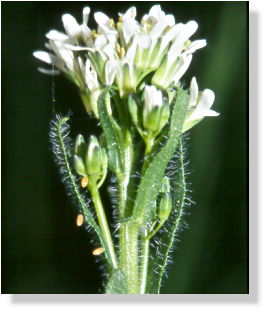 |
The females would continue to fly around a group of five or six plants, that were (?? English name?) Rauhe Gänsekresse (Arabis hirsuta), landing briefly on them, lift off, flutter around to return to the plant and to do the same again. The females were laying eggs on these plants. This group of (??) Rauhe Gänsekresse were the only ones of their kind on the hill top meadow that I could overlook. They are one of only few species that orange tip caterpillars feed on. My text books say that orange tip females only lay a single egg per plant. Apparently, the population of that hill top was short of food plants, so they would not stay with the behaviour described, but would lay all their eggs on this little group of plants. There are already three of them on the very upper part, as the picture shows. Neither the plants nor all of the caterpillars will survive this. Only a few caterpillars, that is, the ones that hatch first, will have enough food to grow and to develop into a chrysalis. |